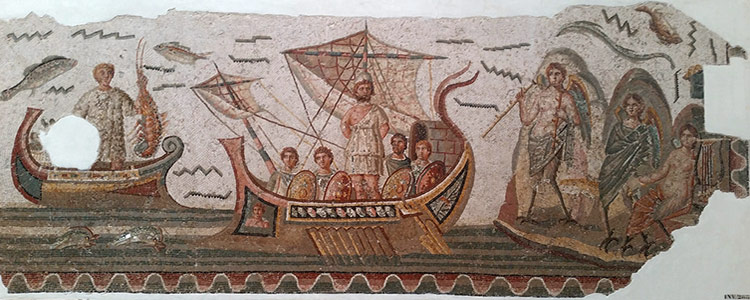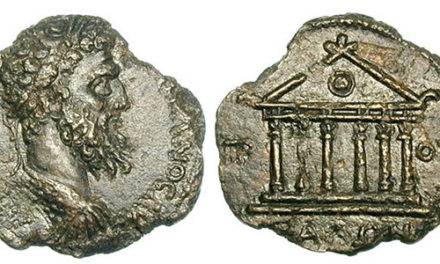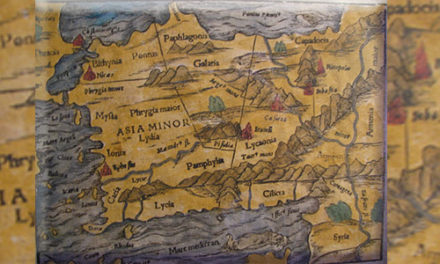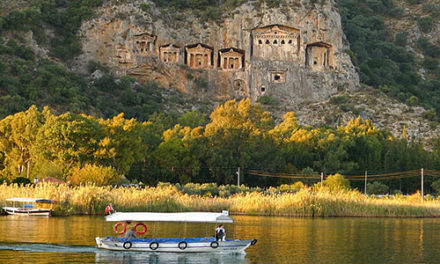Location: North-western Anatolia
Historical capital: Troy
Roman province: Asia
Troas or The Troad is the historical name of the Biga peninsula (modern Turkish: Biga Yarımadası, Greek: Τρωάς) in the northwestern part of Anatolia, Turkey. Ancient district of Troad is bordered by the regions, Mysia in the east, Aeolis in the south, Aegean Sea in the west and Dardanelles in the north. This region has been ruled by the natives of Anatolia, since 3rd millennium BC, and invaded by the Achaeans in the 13th C. BC.
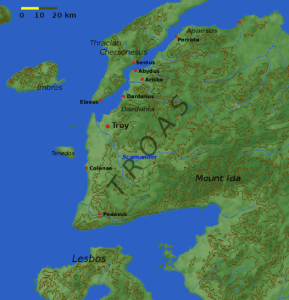 This region now is part of the Çanakkale province of Turkey. Bounded by the Dardanelles to the northwest, by the Aegean Sea to the west and separated from the rest of Anatolia by the massif that forms Mount Ida, the Troad is drained by two main rivers, the Scamander (Karamenderes) and the Simois, which join at the area containing the ruins of Troy. Grenikos, Kebren, Simoeis, Rhesos, Rhodios, Heptaporos and Aisepos were seven rivers of the Troad and the names of the river gods that inhabited each river.
This region now is part of the Çanakkale province of Turkey. Bounded by the Dardanelles to the northwest, by the Aegean Sea to the west and separated from the rest of Anatolia by the massif that forms Mount Ida, the Troad is drained by two main rivers, the Scamander (Karamenderes) and the Simois, which join at the area containing the ruins of Troy. Grenikos, Kebren, Simoeis, Rhesos, Rhodios, Heptaporos and Aisepos were seven rivers of the Troad and the names of the river gods that inhabited each river.
The region later known as the Troad was called Wilusa by the Hittites. This identification was first put forth by Emil Forrer, but largely disputed by most Hittite experts until 1983 when Houwink ten Cate showed that two fragments were from the same original cuneiform tablet and in his discussion of the restored letter showed that Wilusa was correctly placed in northwestern Anatolia. According to Trevor Bryce, Hittite texts indicate a number of Ahhiyawan raids on Wilusa during the 13th century BC, which may have resulted with the overthrow of king Walmu. Bryce also reports that archeological surveys conducted by John Bintliff in the 1970s show that a powerful kingdom that held sway over northwestern Anatolia was based at Troy.
During the migration of Thracians in the 1200s, Troad was populated by various Thracian kin groups. In the 7th C. BC., Troas came under Lydian control and following the destruction of the Lydian kingdom by the Persians in the 6th C. BC., it was ruled by the satraps appointed by the Persian kings. In the end of the 5th C. BC., and beginning of the 4th C. BC., it was ruled by a certain local man Zenis who was from the town Dardanos and controlled by the satrap of Dascylium. On his death, the satrap Pharnabazus appointed his wife Mania to replace him. Mania, in addition to paying regular tribute to Satrap, gathered an army of mercenaries and assisted the Persian satrap in his punishment campaign against Mysians and Pisidians. Although, the local cities of Hamaksitos, Larissa and Colonai revolted and soon supported by Ilium, Neandria and Coyclon, later in 394 BC., Persians were able to control the area again.
With the arrival of Alexander the great after the victory at the battle of Granicus, the whole of Troas along with the rest of Anatolia came under Macedonia. During the war of Diadochoi ( Successors to Alexander the great ), Troad was ruled by Antigonus, Lysimachus and Seleucus in turn. Following the war between the Romans and Seleucid kingdom at the battle of Magnesia in 190 BC., the Romans was victorious, and presented this region to Eumenes II the king of Pergamum, who assisted the Roman army during the battle. Attalus III, the last king of Pergamum bequeathed his kingdom to the Roman Empire, and Troad was annexed by the Romans and incorporated into the province of Asia.The kings of Pergamum (now Bergama) later ceded the territory of the Troad to the Roman Republic. Under the Empire, the territory of the Troad became part of the province of Asia; under the later Byzantine Empire, it was included in the thema of the Aegean Islands. Following its conquest by the Ottoman Empire, the Troad formed part of the sanjak of Biga.
BİBLICAL CONNECTION:
Paul visited Troas. He also refers to Troas when he asks his fellow worker Timothy out of Ephesus, to get his coat there. This was a journey of about 500 km. Paul was accompanied by Luke.

